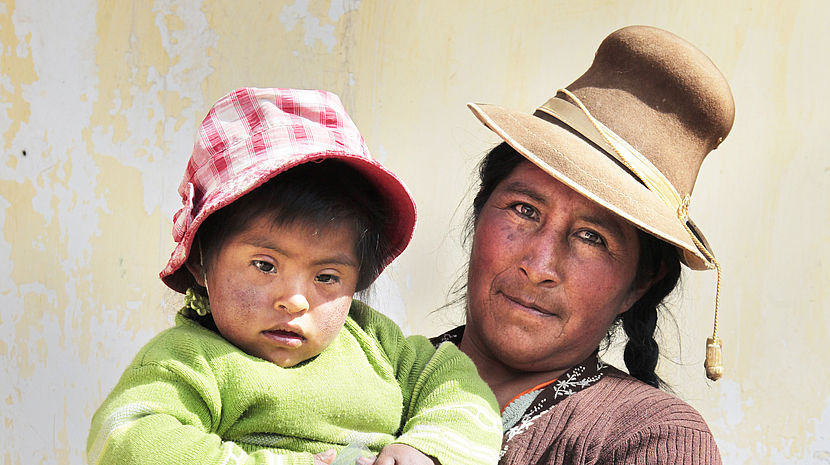09.10.2015 Agenda 2030 and Persons with Disabilities: A Closer Look

The United Nations Sustainable Development Summit took place from 25-27 September in NY with over 9000 participants in attendance. On 25 September at the opening ceremony the 2030 Agenda for Sustainable Development (Agenda 2030) was adopted by 193 Member States. The official adoption was well received with a standing ovation from heads of state and government, as well as civil society representatives (including CBM’s own UN representative, Elizabeth Lockwood).
Persons with disabilities were widely included in the Summit with three particularly powerful examples described below.
First, His Holiness Pope Francis addressed the General Assembly shortly prior to the adoption of Agenda 2030 expressing that “The adoption of the 2030 Agenda for Sustainable Development at the World Summit, which opens today, is an important sign of hope.” Additionally, he included persons with disabilities in his impassioned speech (around the 16-minute mark).
Second, Salil Shetty, Secretary-General of Amnesty International presented as the civil society representative in the opening session of the Summit. In his powerful statement, Shetty stated that “Inequality is the consequence of the failure to protect the rights of the marginalised, Indigenous peoples, minorities, migrants, persons with disabilities,children and the elderly.”
Third, President Obama’s Summit speech on Agenda 2030 on 27 September explicitly included persons with disabilities (20:53-minute mark). He stated “When ethnic and religious minorities or people with disabilities or people of different sexual orientations are discriminated against or can’t access education and opportunity, that holds all of us back. And so in all of our countries we have to invest in the interventions that allow us reach all people because no one should be left behind because of where they live and what they look like.”
Additional references to persons with disabilities during the Summit include, but are not limited to:
- Zeid Ra’ad Al Hussein, High Commissioner of Human Rights, included children with disabilities in his statement at the interactive dialogue on Tackling inequalities, empowering women and girls and leaving no one behind.
- Ghana included persons with disabilities in their Summit speech (20:38 minute mark)
- The African Union included persons with disabilities in their Summit speech (44 minute mark)
- Kolinda Grabar-Kitarović, President of the Republic of Croatia and Co-Chair of the interactive dialogue on Tackling inequalities, empowering women and girls and leaving no one behind mentioned disability in her opening statement.
- Edi Rama, Prime Minister of Albania included persons with disabilities in his statement in the interactive dialogue on Tackling inequalities, empowering women and girls and leaving no one behind.
- Luis Guillermo Solís Rivera, President of Costa Rica included persons with disabilities in his statement in the interactive dialogue on Tackling inequalities, empowering women and girls and leaving no one behind.
- Vladimir Cuk, Executive Director of the International Disability Alliance presented on the rights of persons with disabilities in the interactive dialogue on Tackling inequalities, empowering women and girls and leaving no one behind. Click here to read his full speech.
- Mosharraf Hossain, Director of Policy Influencing of ADD International presented on persons with disabilities in the interactive dialogue on Ending poverty and hunger. Click here to read his full speech.
Agenda 2030 is an ambitious agenda of which the Sustainable Development Goals (SDGs) are a key component. Read more here on details of the full agenda in the context of persons with disabilities. The SDGs contain 17 global goals and 169 targets focused on the three pillars of sustainable development: social, economic and environmental inclusion for all people throughout the world. The SDGs apply to all countries, unlike their predecessor the Millennium Development Goals, which only focused on developing countries. Though the goals are not legally binding in any country, they gain moral force from having been adopted by consensus after three years of in-depth and intense negotiations in which CBM has been actively involved.
United Nations Secretary-General Ban Ki-moon recently expressed that “The true test of commitment to Agenda 2030 will be implementation.” As CBM, we agree and thus will focus on the implementation of Agenda 2030 with partners, particularly at the national and regional levels with linkages back to the global level. Moreover, it is imperative that Agenda 2030 is strongly linked to the UNCRPD in its implementation, and that the UNCRPD serves as a guiding document of Agenda 2030. This is especially important since the UNCRPD is legally binding.
Although the new global agenda has strong elements of disability inclusion, the fight to include persons with disabilities is far from over. The global indicator framework and global monitoring and accountability mechanism must both be inclusive of persons with disabilities. Global indicators currently are being formulated and will be finalised in March 2016. These global indicators must include disaggregation of data by disability where relevant and also specific disability indicators. Read here for more details. The High-Level Political Forum (HLPF) will create the guidance for global monitoring of Agenda 2030 and will be finalised in July 2016. Also, there is a strong focus on sustainable development and Agenda 2030 in the UN’s Second Committee discussions that have just begun at the UN in NY.
Stay tuned for periodic updates on Agenda 2030 and CBM’s work in this process. Thank you everyone for the stellar teamwork!